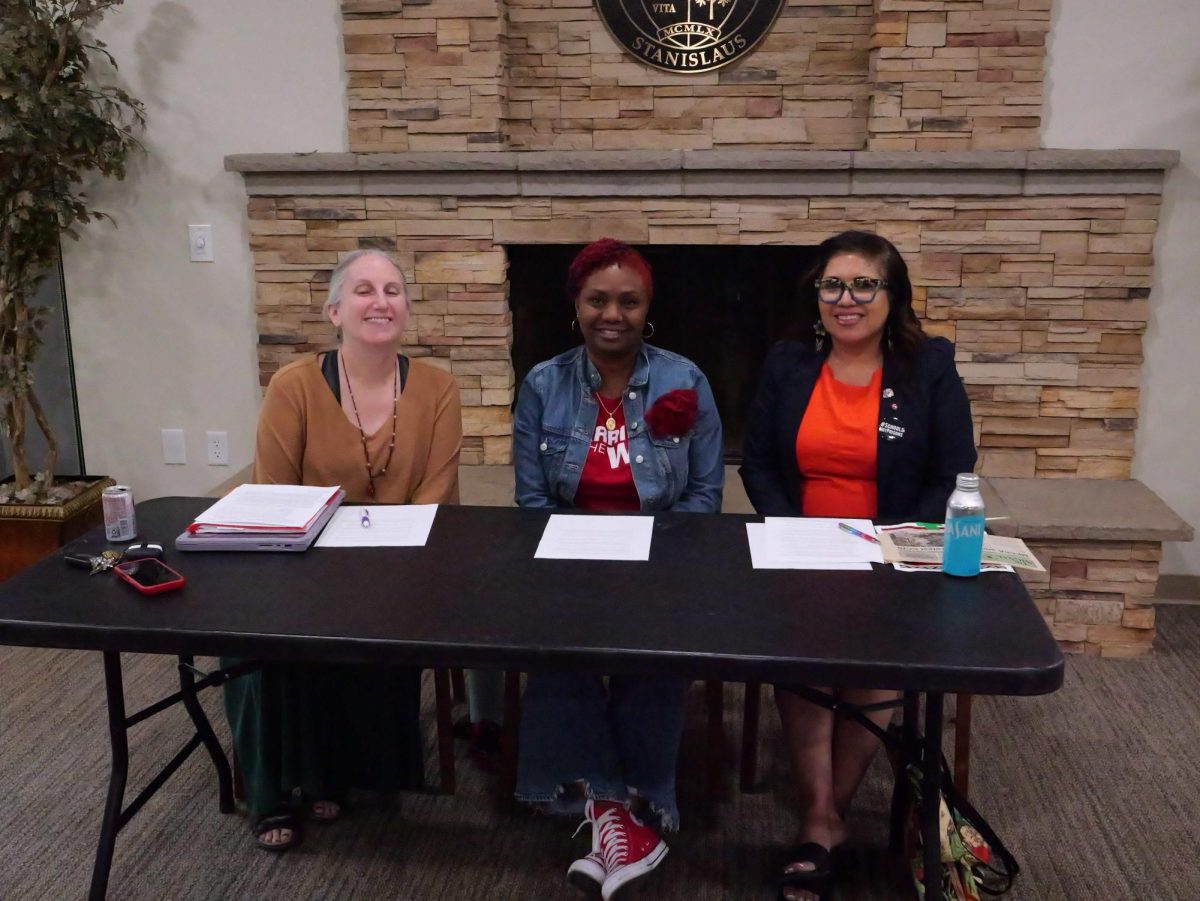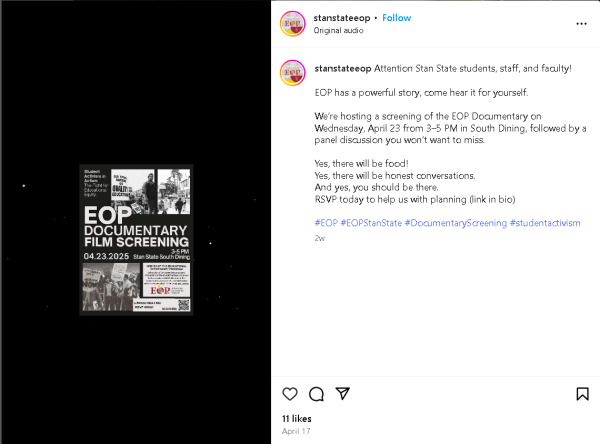
Brandon Vergil
From left: Dr. Jennifer Cullison, Dr. Sacha Joseph-Matthews and Carolina Alfaro, the three panelists who shared commentary following the CSU EOP documentary screening.
Students, staff, and faculty gathered in the South Dining Room at CSU Stanislaus for a screening of the CSU EOP Documentary, a film created by CSU Northridge that traces the origins of the Educational Opportunity Program (EOP) through student protests and faculty activism.
Hosted by Stan State’s own EOP, the event encouraged current students to continue advocating for the program despite an uncertain future.
The documentary detailed EOP roots, featuring interviews with student protesters and faculty involved in the program development. It explored how EOP was formed through grassroots efforts and activism and emphasized the importance of sustaining its mission for future generations.
Following the screening, a panel of Stan State staff, each with their own history of activism, shared their personal experiences and perspectives. Panelists included Dr. Jennifer Cullison, Dr. Sacha Joseph-Matthews and Carolina Alfaro.

Dr. Cullison, an assistant professor for history at Stan State since 2022, is a Bay Area native and first-generation college and PhD student. She began her activism journey in high school, attending a UN leadership conference in 1987 at the end of the Cold War. Upon returning, she started a peace club, wrote letters to the editor, and published articles critical of U.S. foreign policy.
In being an activist scholar, she focused on U.S. immigration as a human rights issue, writing her dissertation on the problems of growth of immigration detention in the U.S. since 1945. She has advocated for immigrant rights since 2007.
Dr. Joseph-Matthews, who is from Trinidad and Tobago, completed her first degree in the Caribbean before earning her MA and PhD at Florida State. Her activism began in high school at an all-girls school in Trinidad, where a major exam determined admission to prestigious high schools; she felt this was a good thing becuase it united students based on academic performance and expose them to students of diverse backgrounds.
In college, she encountered activist teachers advocating for gender equality, which led her to start an organization on campus to advocate for women’s rights and educate others about gender roles.
Upon moving to the U.S., she faced many firsts, being the only black person, woman, and international student in her program. This intersectionality influenced her treatment, with race taking the forefront, helping her understand the black experience in the U.S.
As a professor, she was the only black faculty member in her business school for 17-18 years. During this time, she noticed the varied treatment and needs of students, which positioned her as an accidental activist. This role highlighted the importance of institutional activism.
Eventually, she became an assistant dean for DEI, working on various issues across the campus, not just within the business school.
Alfaro, executive director of the Student Leadership, Engagement, and Belonging Office, comes from a family of Central Valley farm workers and identifies as a proud Chicana. As a high school graduate unsure of her path, she was introduced to Stan State’s EOP by her brothers—alumni from the 1980s. EOP advisors visited her family and showed them a pathway to higher education.
She credits those advisors as some of the first activists she encountered in higher education. Alfaro joined Movimiento Estudiantil Chicano de Aztlán (MEChA), which shaped her identity and approach to activism. She describes herself as a “quiet activist,” advocating through love, collaboration and resource-building.

With her journey of activism, She said that she appreciates the people who have fought before for her and that she’s able to gain access to spaces she wouldn’t have had access to in the past.
The panel explored the legacy of 1960s social justice movements and how those values persist today.
Panelist were asked, “How do you see it connected to social justice movements of the 60s? And how do you see those same values and struggles showing up in the work for your state and higher education?”
Dr. Cullison responded by placing EOP in the context of the 1960s, the narrative of that time and the reality of discrimination.
“But EOP was established in the late ’60s because people still needed it,” she said, emphasizing that civil rights struggles persist today.
Dr. Joseph-Matthews expanded on this, asking whether we are still living in the 1960s, citing ongoing issues such as lack of school funding, attacks on undocumented and Black students, and rising threats to higher education. She warned that progress can be undone if people remain silent.
She said that students are at the forefront of these struggles, and activists have to get creative in terms of what political activity such as civil disobedience can look like.
Alfaro added that it’s important to hold on to past practices while evolving new strategies. “How do we continue to educate, encourage and recognize how powerful student voices are in activism?” she asked. She emphasized the importance of collective efforts and solidarity.
In response to a question about building space for student rage, grief and resistance while maintaining self-care, Dr. Joseph-Matthews acknowledged the depth of student frustration.
“Rage is more than frustration,” she said. “Young people are watching the country backslide, and they need space to express themselves.”
Alfaro agreed, noting the emotional burden of activism and the need for mentors who have navigated similar challenges.
Dr. Cullison added that today’s students face a more precarious environment. “In some places, free speech isn’t protected,” she said. “Being brown and protesting can be dangerous, even for citizens.”
She cited chilling effects such as deportations, revoked student visas and detainments, calling this a new era of suppression. Cullison emphasized that those with privilege and citizenship must step up and support others.
Dr. Cullison says the ‘60s should serve as a model for us because organizers knew how to listen to each other and built movements within and across boundaries.
For more information and resources, Stan State’s Educational Opportunity Program is located in the Vasché Library, Room L230, and online at EOP.
CORRECTION: This article previously incorrectly identified Dr. Jennifer Cullison’s dissertation topic, and was changed to reflect her actual area of expertise in the problems of immigration detention centers and detention rates.